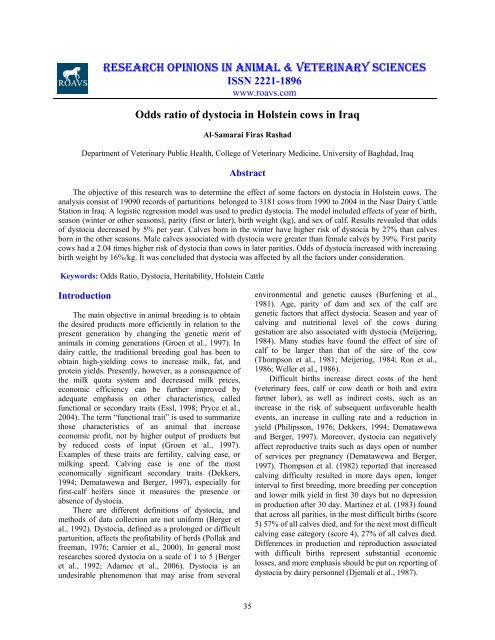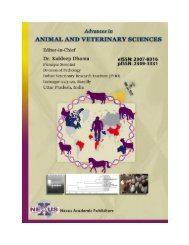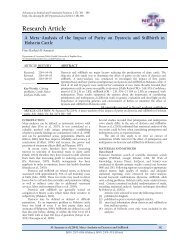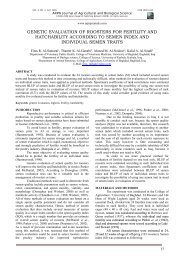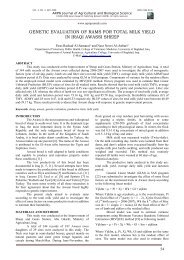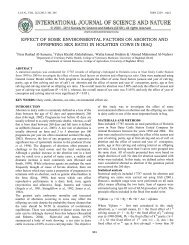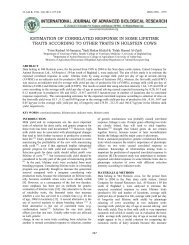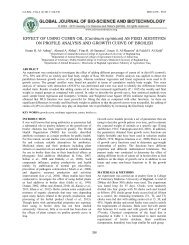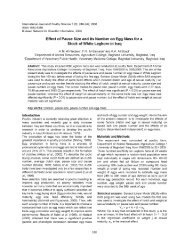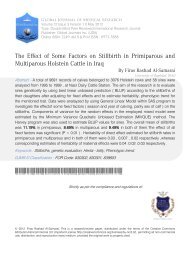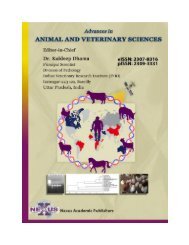Create successful ePaper yourself
Turn your PDF publications into a flip-book with our unique Google optimized e-Paper software.
<strong>RESEARCH</strong> <strong>OP<strong>IN</strong>IONS</strong> <strong>IN</strong> <strong>ANIMAL</strong> & VETER<strong>IN</strong>ARY <strong>SCIENCES</strong><br />
ISSN 2221-1896<br />
www.roavs.com<br />
Odds ratio of dystocia in Holstein cows in Iraq<br />
Al-Samarai Firas Rashad<br />
Department of Veterinary Public Health, College of Veterinary Medicine, University of Baghdad, Iraq<br />
Abstract<br />
The objective of this research was to determine the effect of some factors on dystocia in Holstein cows. The<br />
analysis consist of 19090 records of parturitions belonged to 3181 cows from 1990 to 2004 in the Nasr Dairy Cattle<br />
Station in Iraq. A logistic regression model was used to predict dystocia. The model included effects of year of birth,<br />
season (winter or other seasons), parity (first or later), birth weight (kg), and sex of calf. Results revealed that odds<br />
of dystocia decreased by 5% per year. Calves born in the winter have higher risk of dystocia by 27% than calves<br />
born in the other seasons. Male calves associated with dystocia were greater than female calves by 39%. First parity<br />
cows had a 2.04 times higher risk of dystocia than cows in later parities. Odds of dystocia increased with increasing<br />
birth weight by 16%/kg. It was concluded that dystocia was affected by all the factors under consideration.<br />
Keywords: Odds Ratio, Dystocia, Heritability, Holstein Cattle<br />
Introduction<br />
The main objective in animal breeding is to obtain<br />
the desired products more efficiently in relation to the<br />
present generation by changing the genetic merit of<br />
animals in coming generations (Groen et al., 1997). In<br />
dairy cattle, the traditional breeding goal has been to<br />
obtain high-yielding cows to increase milk, fat, and<br />
protein yields. Presently, however, as a consequence of<br />
the milk quota system and decreased milk prices,<br />
economic efficiency can be further improved by<br />
adequate emphasis on other characteristics, called<br />
functional or secondary traits (Essl, 1998; Pryce et al.,<br />
2004). The term “functional trait” is used to summarize<br />
those characteristics of an animal that increase<br />
economic profit, not by higher output of products but<br />
by reduced costs of input (Groen et al., 1997).<br />
Examples of these traits are fertility, calving ease, or<br />
milking speed. Calving ease is one of the most<br />
economically significant secondary traits (Dekkers,<br />
1994; Dematawewa and Berger, 1997), especially for<br />
first-calf heifers since it measures the presence or<br />
absence of dystocia.<br />
There are different definitions of dystocia, and<br />
methods of data collection are not uniform (Berger et<br />
al., 1992). Dystocia, defined as a prolonged or difficult<br />
parturition, affects the profitability of herds (Pollak and<br />
freeman, 1976; Carnier et al., 2000). In general most<br />
researches scored dystocia on a scale of 1 to 5 (Berger<br />
et al., 1992; Adamec et al., 2006). Dystocia is an<br />
undesirable phenomenon that may arise from several<br />
environmental and genetic causes (Burfening et al.,<br />
1981). Age, parity of dam and sex of the calf are<br />
genetic factors that affect dystocia. Season and year of<br />
calving and nutritional level of the cows during<br />
gestation are also associated with dystocia (Meijering,<br />
1984). Many studies have found the effect of sire of<br />
calf to be larger than that of the sire of the cow<br />
(Thompson et al., 1981; Meijering, 1984; Ron et al.,<br />
1986; Weller et al., 1986).<br />
Difficult births increase direct costs of the herd<br />
(veterinary fees, calf or cow death or both and extra<br />
farmer labor), as well as indirect costs, such as an<br />
increase in the risk of subsequent unfavorable health<br />
events, an increase in culling rate and a reduction in<br />
yield (Philipsson, 1976; Dekkers, 1994; Dematawewa<br />
and Berger, 1997). Moreover, dystocia can negatively<br />
affect reproductive traits such as days open or number<br />
of services per pregnancy (Dematawewa and Berger,<br />
1997). Thompson et al. (1982) reported that increased<br />
calving difficulty resulted in more days open, longer<br />
interval to first breeding, more breeding per conception<br />
and lower milk yield in first 30 days but no depression<br />
in production after 30 day. Martinez et al. (1983) found<br />
that across all parities, in the most difficult births (score<br />
5) 57% of all calves died, and for the next most difficult<br />
calving ease category (score 4), 27% of all calves died.<br />
Differences in production and reproduction associated<br />
with difficult births represent substantial economic<br />
losses, and more emphasis should be put on reporting of<br />
dystocia by dairy personnel (Djemali et al., 1987).<br />
35
Rashad roavs, 2011, 1(1): 35-39<br />
Dystocia may also contribute to additional<br />
management costs for continuous surveillance of<br />
parturient cows. Dematawewa and Berger (1997)<br />
estimated costs associated with dystocia to be $0.00,<br />
50.45, 96.48, 159.82, and 397.61 for no assistance,<br />
slight assistance, needed assistance, considerable force<br />
needed, and extreme difficulty respectively. Also,<br />
Dematawewa and Berger (1997) estimated total average<br />
cost of dystocia for primiparous cows was $28.01<br />
compared with $11.10 for multiparous cows. In a<br />
different analysis, Dekkers (1994) calculated dystocia<br />
costs to be $43.11 and $20.25 for first and later parities<br />
respectively.<br />
The objectives of this study were 1) to determine<br />
the frequency of dystocia in field data for Holstein<br />
cows 2) to determine the factors affecting dystocia and<br />
3) to estimate heritability of dystocia by using the sire<br />
of calf as a source of variation in estimation of variance<br />
component.<br />
Materials and Methods<br />
Records on Holstein parturitions were analyzed<br />
from 1990 to 2004 in the Nasr Dairy Cattle station in<br />
Iraq. Twin calves were ignored from the analysis,<br />
because we were primarily interested in what causes<br />
correctly single-born calves to be difficult to deliver.<br />
However, twins are noted to have higher dystocia rates<br />
than singletons (Johanson et al., 2001). The data of the<br />
present study were divided into two categories (assisted<br />
and unassisted). Johanson and Berger, (2003) point out<br />
that the best way to align the recording system was to<br />
condense the five dystocia categories down to only two,<br />
assisted and unassisted. Season was classified as winter<br />
and other seasons, because of the weather in Iraq was<br />
hot in most months and nearly cold in a few months.<br />
Winter included December, January, February and<br />
March while other seasons included the residual<br />
months.<br />
Because dystocia is binary trait, a traditional<br />
regression model for a continuous trait cannot be used.<br />
We chose to use logistic regression to model dystocia.<br />
Logistic regression handles binary variables well and<br />
gives results that are easy to interpret. The logistic<br />
regression analysis was done using PROC LOGISTIC<br />
in SAS (2001). Odds ratios (OR) are another useful way<br />
to interpret results from a logistic regression analysis<br />
(Kleinbaum, 1994; Hosmer and Lemeshow, 2000). An<br />
OR compares two opposing probabilities to determine<br />
which is more problematic. For example, we may want<br />
to compare dystocia in male calves versus dystocia in<br />
female calves. If the OR is exactly equal to 1, then there<br />
is no difference between the sexes for the odds of<br />
dystocia. In that case, sex of the calf would not be a<br />
good predictor of dystocia. If the OR is 1.5, we<br />
interpret this value as meaning male calves have a 50%<br />
greater chance of dystocia than female calves given that<br />
all other variables are the same. An OR of 2 is double<br />
the risk. The OR above was for a discrete variable such<br />
as sex of calf. An OR can also be calculated for a<br />
continuous variable. This type of OR can be interpreted<br />
as a linear trend over the range of the variable. For<br />
example, an OR of 1.05 for year is interpreted as a 5%<br />
increase in the OR for dystocia for the next year while<br />
the other variables are held constant. Suppose all calves<br />
born in 1990 have a 10% chance of incidence of<br />
dystocia, then all calves born in 1991 have a 10.5%<br />
(10% × 1.05) chance of incidence of dystocia.<br />
Statistical analysis<br />
Odds ratio for dystocia was estimated by using the<br />
following model:<br />
Log (ΠDYS/ (1 − ΠDYS)) = β0 + β1Y + β2 S + β3 G +<br />
β4P + β5BW,<br />
Where ΠDYS is the probability of dystocia.<br />
Y is year of calving (Linear trend), S is season of<br />
calving, G is sex of calf, p is parity, and BW is birth<br />
weight of calf (Linear trend).<br />
Variance components were obtained by MIVQUE<br />
(Rao, 1971) using the following model:<br />
Yijklmno = µ + Ai + Yj + Gk + Pl + Wm + Sn +<br />
eijklmno<br />
Yijklmno denotes a 0 or 1 for normal vs. dystocia,<br />
µ = the overall mean,<br />
Ai = fixed effect of the ith season of calving,<br />
Yj = fixed effect of jth year of calving,<br />
Gk = fixed effect of kth sex of calf,<br />
Pl = fixed effect of lth parity,<br />
Wm = fixed effect of weight of calf,<br />
Sn = random effect of calf’s sire<br />
eijklmno = residual effect.<br />
Results and Discussion<br />
The overall means of dystocia was 15.24% (Table<br />
1), the present estimation is within estimates obtained<br />
by several researchers 5.08 – 16.3% ( Weller et al.,<br />
1988; Manffredi et al., 1991; Heins et al., 2001; Cassell,<br />
2005). Table 2 gives parameters along with their<br />
estimates for factors affecting dystocia. The first thing<br />
that one may notice is the significant effect of all<br />
factors on dystocia. Also note that the quadratic term<br />
for birth weight is not necessary to predict dystocia.<br />
This is due to the fact that smaller than average birth<br />
weights do not need assistance as often as larger than<br />
average birth weights. Hence the linear trend of birth<br />
weight is sufficient to model the increase in dystocia<br />
(Johanson and Berger, 2003).<br />
Table 3 presents estimates of the OR for the factors<br />
affecting dystocia. Results revealed that birth season<br />
has significant effect (P
Rashad roavs, 2011, 1(1): 35-39<br />
Table 1: Least square means of factors affecting<br />
dystocia<br />
Effect<br />
No. of<br />
Observation<br />
Least squares<br />
means ± SE %<br />
Overall means 19090 15.24 ± 0.07<br />
Calving season<br />
Winter 5256 15.26 ± 0.14<br />
Other seasons 13834 15.89 ± 0.09<br />
Parity<br />
1 5079 16.65 ± 0.14<br />
2 + 14011 14.51 ± 0.09<br />
Sex<br />
Male 9808 16.44 ± 0.11<br />
Female 9282 14.72 ± 0.11<br />
Table 2: Parameter estimates for dystocia<br />
Parameter Pro> Estimate ± SE<br />
Intercept 0.0001 84.2193 ± 14<br />
Season 0.0001 0.2398 ± 0.06<br />
Year 0.0001 - 0.0476 ± 0.007<br />
Sex 0.0001 0.3300 ± 0.02<br />
Parity 0.0001 0.7141 ± 0.05<br />
BW 0.0001 0.1519 ± 0.007<br />
BW = Birth weight<br />
in the winter have a 27% higher risk of dystocia than<br />
calves born in the other seasons. These results were<br />
higher than 15% which was reported by Johanson and<br />
Berger (2003). Pollak and Freeman (1976) found that<br />
more dystocia was in winter (October through March)<br />
due to male calves were significantly larger than female<br />
and experienced more dystocia. Also McClintock et al.<br />
(2005) reported that incidence of dystocia in Holsteins<br />
was influenced by the season due to gestation lengths<br />
were longer in winter, resulting in larger calves and<br />
more dystocia. Two hypotheses explaining this, first,<br />
cows calving in summer may be in better physical<br />
condition to calve. Second, herdsmen may have more<br />
time in winter to witness and aid in delivery of calves<br />
(Pollak and Freeman, 1976).<br />
The estimate of the OR for year indicated that there<br />
is a 5% decrease in dystocia per year. For example, if<br />
the incidence of dystocia is 16.3% in a given year, then<br />
it will decrease to 15.4% (0.163 × 0.95) the next year.<br />
The differences in dystocia due to years of calving were<br />
significant (P
Rashad roavs, 2011, 1(1): 35-39<br />
Table 4: Variance component and heritability<br />
estimates obtained with the linear model<br />
analyses<br />
Parameter<br />
Variance components<br />
Sire variance 5.78<br />
Residual variance 186.09<br />
Heritability (h²) 0.12<br />
dystocia in all parities and would allow inclusion of<br />
data from later parity animals for improved accuracy in<br />
evaluating sires for use on virgin heifers. Discussion<br />
also exists as to whether dystocia should be considered<br />
a trait of the calf or a trait of the dam and what about<br />
the correlations of sire rankings as a trait of the calf<br />
with sire rankings as a trait of the dam? Finally a<br />
multitrait analysis has been suggested (Van Vleck and<br />
Edlin, 1984), but little would be gained if later parity<br />
heritability and the genetic correlation between first and<br />
later parities are low. However, a multi trait threshold<br />
analysis is considerably more complex than a single<br />
trait analysis (Foulley et al., 1987).<br />
Results clearly demonstrate that dystocia was<br />
affected by all factors in the employed model and parity<br />
has the highest effect on dystocia. The low estimate of<br />
heritability for dystocia indicates the importance of<br />
environmental factors in the variation of the trait.<br />
References<br />
Adamec, V., Cassell, B.G., Smith, E.P. and Pearson,<br />
R.E. 2006. Effects of inbreeding in the dam on<br />
dystocia and stillbirths in US Holsteins. Journal of<br />
Dairy Science, 89: 307–314.<br />
Al-Samarai, F.R., Al-Anbari, N.N. and Al-Doori, Z.T.<br />
2006. Estimation of genetic merit of sires in a herd<br />
of Holstein for many generations depending on<br />
their calves birth weight. Journal of Tikrit<br />
University for Agriculture Science. 3: 11- 18.<br />
Berger, P.J., Cubas, A.C.,Koehler, K.J. and Healey,<br />
M.H.1992. Factors affecting dystocia and early calf<br />
mortality in Angus cows and heifers. Journal of<br />
Animal Science, 70: 1775 – 1786.<br />
Burfening, P.J., Kress, D.D. and Friedrich, R.L. 1981.<br />
Calving ease and growth rate of Simmental-sired<br />
calves. 111. Direct and maternal effects. Journal of<br />
Animal Science, 53: 1210 – 1212.<br />
Cady, R.A. 1980. Evaluation of Holstein bulls for<br />
dystocia. Ph.D. dissertation. Comell University,<br />
Ithaca, NY.<br />
Carnier, P., Albera, A., Dal Zotto, R., Groen, A.F.,<br />
Bona, M. and Bittante, G. 2000. Genetic<br />
parameters for direct and maternal calving ability<br />
over parities in Piedmontese cattle. Journal of<br />
Animal Science, 78: 2532–2539.<br />
Cassell B., McAllister, A., Nebel, R., Franklin, S.,<br />
Getzewich, K., Ware, J., Cornwell, J. and Pearson<br />
R. 2005.Birth weights, mortality, and dystocia in<br />
Holsteins, Jerseys, and their reciprocal crosses in<br />
the Virginia Tech and Kentucky crossbreed project.<br />
Journal of Dairy Science, 88: (Suppl.1),<br />
94.(Abstr.).<br />
Dekkers, J.C.M. 1994. Optimal breeding strategies for<br />
calving ease. Journal of Dairy Science, 77: 3441–<br />
3453.<br />
Dematawewa, C.M.B. and Berger. P.J. 1997. Effect of<br />
dystocia on yield, fertility, and cow losses and an<br />
economic evaluation of dystocia scores for<br />
Holsteins. Journal of Dairy Science, 80: 754 – 761.<br />
Djemali, M., Freeman, A.E. and Berger, P.J. 1987.<br />
Reporting of dystocia scores and effects of dystocia<br />
on production, days open, and days dry from Dairy<br />
Herd Improvement data. Journal of Dairy Science,<br />
70: 2127 – 2135.<br />
Essl, A. 1998. Longevity in dairy cattle breeding: A<br />
review. Livestock Production Science, 57: 79–89.<br />
Foulley, J. L., Gianola, D. and Hoschele, I. 1987.<br />
Empirical Bayes estimation of parameters for<br />
polygenic binary traits. Genetics Selection<br />
Evolution, 19: 197 – 206.<br />
Groen, A. F., Steine, T., Colleau, J.J., Pedersen, J.,<br />
Pribyl, J. and Reinsch, N. 1997. Economic values<br />
in dairy cattle breeding, with special reference to<br />
functional traits. Report of an EAAP-working<br />
group. Livestock Production Science, 49: 1–21.<br />
Heins, B.J., Hansen, L.B., Seykora, A.J. and Marx,<br />
G.D. 2001.Calving disorders of Holstein cows<br />
selected for large versus small body. Journal of<br />
Dairy Science, 84: ( Suppl. 1),1018 (Abstr.).<br />
Hosmer, D.W. and Lemeshow, S. 2000. Applied<br />
Logistic Regression. 2nd Ed. John Wiley & Sons,<br />
Inc., New York, NY.<br />
Johanson, J.M. and Berger, P.J. 2003. Birth weight as a<br />
predictor of calving ease and perinatal mortality in<br />
Holstein cattle. Journal of Dairy Science, 86:<br />
3745–3755.<br />
Johanson, J.M., Berger, P.J., Kirkpatrick, B.W. and<br />
Dentine, M.R. 2001. Twinning rates of North<br />
American Holstein sires. Journal of Dairy Science,<br />
84: 2081–2088.<br />
Kleinbaum, D.G., 1994. Logistic Regression: A selflearning<br />
text. Springer-Verlag New York, Inc.,<br />
New York, NY.<br />
Lombard, J.E., Garry, F.B., Tomlinson, S.M. and<br />
Garber, L.P. 2007. Impacts of dystocia on health<br />
and survival of dairy calves. Journal of Dairy<br />
Science, 90: 1751 – 1760.<br />
Manfredi, M., Ducrocq, V. and Foully, L. 1991.<br />
Genetic analysis of dystocia in dairy cattle. Journal<br />
of Dairy Science, 74: 1715 – 1723.<br />
38
Rashad roavs, 2011, 1(1): 35-39<br />
Mangurkar, B. R., Hayes, J.F. and Moxley, J.E. 1984.<br />
Effects of calving ease-calf survival on production<br />
and reproduction in Holsteins. Journal of Dairy<br />
Science, 67: 1496 – 1509.<br />
Martinez, M. L., Freeman, A.E. and Berger, P.J. 1983.<br />
Factors affecting calf livability for Holsteins.<br />
Journal of Dairy Science, 66:2400 - 2407.<br />
McClintock, S., Kevin, B., Wells, M. and Michael, G.<br />
2005. Calving difficulty in Holsteins and Jerseys<br />
and their crossbreeds. Journal of Dairy Science,<br />
87:(Suppl. 1), 533.(Abstr.).<br />
Meijering, A. 1984. Dystocia and stillbirth in cattle. a<br />
review of causes, relations and implications.<br />
Livestock Production Science.11:143 – 149.<br />
Philipsson, J. 1976. Studies on calving difficulty,<br />
stillbirth, and associated factors in Swedish cattle<br />
breeds. V. Effects of calving performance and still<br />
birth in Swedish Friesian heifers on productivity in<br />
the subsequent lactation. Acta Agriculturae<br />
Scandinavica, 26: 230 – 238.<br />
Philipsson, J., Foulley, J.L., Lederer, J., Liboriussen, T.<br />
and Osinga, A. 1979. Sire evaluation standards and<br />
breeding strategies for limiting dystocia and stillbirth.<br />
Livestock Production Science, 6: 111- 127.<br />
Pollak, E. J. and Freeman, A.E. 1976. Parameter<br />
estimation and sire evaluation for dystocia and calf<br />
size in Holsteins. Journal of Dairy Science, 59:<br />
1817- 1824.<br />
Pryce, J. E., Royal, M.D., Garnsworthy, P.C. and Mao,<br />
I.L. 2004. Fertility in the high-producing dairy<br />
cow. Livestock Production Science, 86: 125–135.<br />
Rao, C.R. 1971. Minimum variance quadratic unbiased<br />
estimation of variance component. Journal of<br />
Multivariate Analysis, 1: 445-456.<br />
Ron, M., Bar-Anan, R. and Welter, J.I. 1986. Sire and<br />
maternal grandsire effects on calving difficulty and<br />
calf mortality in Israeli Holsteins. Journal of Dairy<br />
Science, 69: 243 – 247.<br />
SAS, 2001. SAS/STAT Users Guide for Personal<br />
Computer. Release 6.12.SAS Institute, Inc., Cary,<br />
N.C., USA.<br />
Thompson, J.R., Freeman, A.E. and Berger, P.J. 1981.<br />
Age of dam and maternal effects for dystocia in<br />
Holsteins. Journal of Dairy Science, 64: 1603 –<br />
1612.<br />
Thompson, J. R., Pollak, E.J. and Pelissier, C.L. 1982.<br />
Effects of calving difficulty on production and<br />
reproduction in the subsequent lactation in large<br />
California dairy herds. Journal of Dairy Science,<br />
65:(Suppl. 1), 87.(Abstr.)<br />
Van Vleck, L. D. and Edlin, K.M. 1984. Multiple trait<br />
evaluation of bulls for calving ease. Journal of<br />
Dairy Science, 67: 3025 – 3032.<br />
Weller, J. I., Ezra, E. and Bar-Anan, R. 1986. Studies<br />
on the model of choice for genetic analysis of<br />
calving traits. Journal of Dairy Science, 69: (Suppl.<br />
1), 124.(Abstr.)<br />
Weller, J. I., Miszaal, I. and Gianola, D. 1988. Genetic<br />
analysis of dystocia and calf mortality in Israeli-<br />
Holsteins by threshold and linear models. Journal<br />
of Dairy Science, 71: 2491-2501.<br />
39


